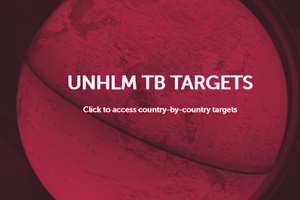The Stop TB Partnership, the Global Fund to Fight AIDS, TB and
Malaria and the World Health Organization call for immediate
action to implement the commitments made by Head of States and
Governments at the UN High-Level Meeting on TB.
6 August 2019 I Geneva, Switzerland – Nearly one year
after the first-ever United Nations High-Level Meeting on
Tuberculosis, the Stop TB Partnership, the Global Fund to Fight
AIDS, Tuberculosis and Malaria, and the World Health
Organization call for immediate action to implement the
commitments that were made by Head of States and Governments.
Targets that were agreed in the October 2018 Political
Declaration of the High-Level Meeting of the General Assembly on
the Fight Against Tuberculosis for 2018-2022 are: (1) to provide
appropriate diagnosis and treatment to 40 million people with
TB, including 3.5 million children and 1.5 million people with
drug-resistant TB; (2) to reach at least 30 million people with
preventive treatment, including 4 million children under the age
of five, 6 million people living with HIV and 20 million other
household contacts of people affected by TB; (3) to mobilize
US$13 billion annually needed by 2022 for implementation; and
(4) to mobilize US$2 billion annually for TB research and
innovation.
These ambitious and time-bound targets will only be achieved if
all political leaders, particularly in the countries with the
highest burdens of TB, take urgent action to ensure that their
country can achieve their national share of the global targets
for the treatment of TB and preventive treatment and that
countries work together to mobilize the necessary resources. The
Stop TB Partnership, the Global Fund to Fight AIDS, Tuberculosis
and Malaria, and the World Health Organization are committed to
working with all partners to support countries in their work in
planning and implementing these actions.
TB is now the world’s leading infectious killer,
surpassing even HIV. In 2017, TB killed 1.6 million people,
including 300,000 HIV-positive people.
“It is critical to put the foot on the pedal, to save
millions from illness, suffering and death,” said Dr.
Tereza Kasaeva, Director of the WHO’s Global TB Program.
“This is why WHO Director-General Dr. Tedros Adhanom
Ghebreyesus recently
sent letters
to Head of States of the highest-burden countries highlighting
the need for strong and visionary leadership now more than
ever.”
The Stop TB Partnership, in collaboration with Avenir Health,
has produced a breakdown of what the global 40 million and 30
million treatment targets mean for each country, using the
latest estimates of TB disease burden and data on case
notifications published by WHO. This
country-by-country breakdown
(http://www.stoptb.org/resources/countrytargets/) provides indicative targets and benchmarks that could be used
to inform country dialogue, further refinement and development
of official national and sub-national targets, linked to the
development and updating of national strategic plans for TB and
associated funding requests, including to the Global Fund.
Several high-TB burden countries have already started to use
these indicative targets to plan their actions towards ending
TB, and others must do so as well if we are to collectively
achieve the targets of the High-Level Meeting.
“The UN High-Level Meeting in 2018 demonstrated much
greater political commitment to tackling TB, but now we need to
deliver. We urgently need increased international funding to
fight TB, and increased domestic resource mobilization,”
said Peter Sands, Executive Director of the Global Fund.
“Together, we must step up the fight to diagnose and cure
the millions currently being left untreated and to counter the
threat of drug-resistant TB. We can only reach the goal of
ending TB as an epidemic by 2030 if we act now.”
In 2020, the UN Secretary-General will provide, with support
from the WHO Director-General, a progress report on global and
national progress towards achieving the commitments made in the
2018
Political Declaration
of the High-Level Meeting of the General Assembly on the Fight
Against TB, which will serve to inform preparations for a
comprehensive review by Heads of State and Government at a
follow-up High-Level Meeting on TB in 2023.
“Every single country in the world has people with TB to
be diagnosed, treated and cured, and financial investments to be
made in TB programs. The global, collective targets are to be
achieved only if everyone achieves their part and keeps their
commitments. It is an amazing joint effort that we have to do by
the end of 2022. I hope that every country program will use
their indicative ‘share’ of targets that we are
presenting here today,” said Dr. Lucica Ditiu, Executive
Director, the Stop TB Partnership.
|
***********************************************************
|
|
|
***********************************************************
|
|
About the Global Fund: The Global Fund is a
partnership designed to accelerate the end of AIDS, tuberculosis
and malaria as epidemics. As an international organization, the
Global Fund mobilizes and invests more than US$4 billion a year
to support programs run by local experts in more than 100
countries. In partnership with governments, civil society,
technical agencies, the private sector and people affected by
the diseases, we are challenging barriers and embracing
innovation.
About the Stop TB Partnership: The Stop TB
Partnership is a unique international organization at the
forefront of the global TB response, bringing together
expertise, innovation, medicines and diagnostics, and
people-centered services from a broad range of partners with a
shared vision to end TB by 2030.
Source:
Stop TB Partnership


